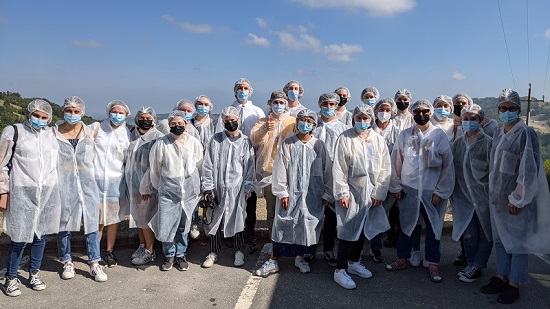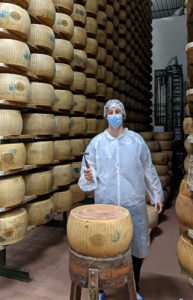Food, Sustainability, & Environment Students Visit Italian Gastronomic Heartland

Last weekend, students in Umbra’s program for Food, Sustainability, & Environment (FSE) went to Parma and Modena for what is one of the most significant field trips of their study abroad experience.
Accompanied by the three co-instructors of the FSE core course—Umbra’s director, Prof. Zachary Nowak, Professor Clelia Viecelli, and FSE assistant Manuel Barbato—students visited a region considered the cradle of Italian gastronomic culture, Emilia Romagna. This area is home of three worldwide known culinary gems: Parmesan cheese, Parma ham, and Modena balsamic vinegar.
The first stop was the Salumificio ‘La Perla’, located in the beautiful hills above Parma. Students met Carlo Lanfranchi, who was their guide through the small, family-run factory where over ten thousand fresh Italian hams are turned into delicious prosciutto each year. Students saw the various stages of salting and Carlo explained the special final quality test, which requires a small horse-bone probe to check for defects. The group then went upstairs for a hearty lunch of tortellini and (of course) prosciutto.

After the evening and night in Parma, students left Saturday morning for the Consorzio Produttori Latte Parma, where twelve local dairy farmers have created a small cooperative to process the milk from their cows into the famous cheese. Students were able to see the process of cheese-making from the beginning (as the workers pulled the curds out of the huge copper kettles with thick cheesecloths) to the salting, and even went in the huge warehouse where finished wheels of cheese weighing over 150 pounds each were stacked on shelves that went to the ceiling.
The last stop on the trip was in Modena, a small city known for being home of luxury cars (Ferrari and Lamborghini factories) and…balsamic vinegar. Students visited Acetaia San Donnino, a family-run business where students were able to see the six different sets of wooden barrels (each made of a different wood) that balsamic vinegar must pass through on its twelve year-long journey to becoming Modena’s most famous culinary product. A real hit: tasting the thick, syrupy balsamic vinegar on vanilla ice cream!
In addition to visiting some of the Italian food excellencies, and tasting authentic products, students had the opportunity to have hands-on experience on many aspects related to food production and consumption. They learned the importance of the geographical indications that aim to protect the names of specific products and their unique characteristics, linked to their geographical origin as well as traditional know-how. They learned how crucial is the use of high-quality raw material (and the daily quality controls) in such traditional products. They learned the indissoluble link between parmigiano, prosciutto and vinegar and the people and history of Parma and Modena. But, at the same time, students realized how important is the interplay between innovation and tradition.
During the upcoming weeks, students will have the opportunity to visit and learn more about the interconnection between food, sustainability, and environment thanks to workshops and on-site visits in that landscape of culinary wonders, called Umbria.